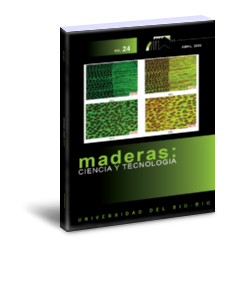Predictive expressions for withdrawal force capacity of various size of dowels from particleboard and medium density fiberboard
DOI:
https://doi.org/10.4067/s0718-221x2022000100436Keywords:
Dowel, dowel joints, medium density fiberboard, particleboard, predictive expression, withdrawal force capacityAbstract
The objective of this study was to develop predictive expressions for estimating the withdrawal force capacity of various size of beech (Fagus orientalis) dowels from medium density fiberboard (MDF) and particleboard (PB). Furthermore, effects of the base material type, dowel diameter, dowel penetration and adhesive type on withdrawal force capacity were investigated. Polyurethane (PU), polyvinyl acetate based D2, and polyvinyl acetate (PVA) adhesives were utilized for gluing of dowels. A total of 540 specimens were prepared for edge and face withdrawal force capacity tests including two material types (MDF, PB), three dowel diameters (6 mm, 8 mm, 10 mm), three dowel penetration depths (15 mm, 20 mm, 25 mm for edge, 6 mm, 9 mm, 12 mm for face), three adhesive types and five replications for each group. Specimens were tested under static withdrawal forces. Based on results of tests, predictive expressions that allow furniture engineers to estimate edge and face dowel withdrawal force capacity as a function of dowel diameter and dowel penetration were developed. Calculations showed that the expressions developed provided reasonable estimates for withdrawal force capacity of dowels. As a result of statistical analyses, material type, dowel diameter, dowel penetration, adhesive type and their four-way interaction have significantly affected the withdrawal force capacity of dowels. Test results also indicated that PU adhesive and MDF ranked the highest withdrawal force capacity among the adhesive and material types. Increasing either dowel diameter or penetration tended to have a positive effect on withdrawal force capacity. Dowel diameter was found to have a higher effect on withdrawal force capacity than dowel penetration.
Downloads
References
American Society for Testing and Materials. 2001. ASTM D1037-99: Standard test methods for evaluating properties of wood-base fiber and particle panel materials. ASTM. West Conshohocken, PA, USA. https://www.astm.org/Standards/D1037.htm
American Society for Testing and Materials. 2001. ASTM D4442-92: Standard test methods for direct moisture content measurement of wood and wood-base materials. ASTM. West Conshohocken, PA, USA. https://www.astm.org/Standards/D4442.htm
American Society for Testing and Materials. 2018. D5764-97a: Standard Test Method for Evaluating Dowel-Bearing Strength of Wood and Wood-Based Products. ASTM International, West Conshohocken, PA, USA. www.astm.org
Eckelman C.A. 1971. Bending strength and moment-rotation characteristics of two-pin moment resisting dowel joints. Forest Prod J 21: 35–39. https://agris.fao.org/agris-search/search.do?recordID=US201301155620
Eckelman, C.A.; Cassens, D.L. 1985. Withdrawal strength of dowels from wood composites. Forest Prod J 35(5): 55-60. https://pascal-francis.inist.fr/vibad/index.php?action=getRecordDetail&idt=9173060
Eckelman, C.A.; Erdil, Y.Z.; Zhang, J. 2002. Withdrawal and Bending Strength of Dowel Joints Constructed of Plywood and Oriented Strandboard. Forest Prod J 52(9): 66-75. https://www.agriculture.purdue.edu/fnr/faculty/eckelman/documents/d200209a_000.pdf
Englesson, T.; Osterman, A. 1972. Assembly of chipboard with round dowels. Swedish Forest Products Research Laboratory, Stockholm, Report 208.
Erdil, Z.Y.; Eckelman, C.A. 2001. Withdrawal strength of dowels in plywood and oriented strand board. Turk J Agric 25: 319–327. https://journals.tubitak.gov.tr/agriculture/issues/tar-01-25-5/tar-25-5-5-0007-20.pdf
Erdil, Y.Z.; Zhang, J.; Eckelman, C.A.; 2003. Withdrawal and bending strength of dowel-nuts in plywood and oriented strandboard. Forest Prod J 53(6): 54. https://www.proquest.com/openview/5ec6adfada6d5f1e507169a6e288af8c/1?pq-origsite=gscholar&cbl=25222
European Committee for Standardization. 2014. BS EN 1995-1-1: Design of Timber Structures. Part 1-1: General rules and rules for buildings. https://www.en-standard.eu/bs-en-1995-1-1-2004-a2-2014-eurocode-5-design-of-timber-structures-general-common-rules-and-rules-for-buildings/?gclid=CjwKCAjwnPOEBhA0EiwA609ReW9R77FaShe6YwyctPRl1MJ4XZViOHREgF0h65K_ahL0WlDiV_jTFRoCWX0QAvD_BwE
European Committee for Standardization. 2016. BS EN 204: 2016: Classification of thermoplastic wood adhesives for non-structural applications. https://www.en-standard.eu/bs-en-204-2016-classification-of-thermoplastic-wood-adhesives-for-non-structural-applications/?gclid=CjwKCAjwnPOEBhA0EiwA609ReSbRSuLiFRnr8DM6jSqra5N1WdbJgDuQFXvphUQ2ldkHoonLNaheYxoCRssQAvD_BwE
Itani, R.Y.; Faherty, K.F. 1984. Structural wood research: state-of-the-art and research needs. American Society of Civil Engineers, New York, NY. USA. 210p. https://cedb.asce.org/CEDBsearch/record.jsp?dockey=0042890
Johansen, K.W. 1949. Theory of timber connections. Int Assoc Bridge Struct Eng 9: 249–262. http://doi.org/10.5169/seals-9703
Karaman, A. 2021. Effects of wooden-dowel species, edge banding thickness, and adhesive types on withdrawal strength in MDF-Lam. Wood Mat Sci Eng 1-10. https://doi.org/10.1080/17480272.2021.1881999
Kasal, A. 2007. Determination of the dowel holding performance of some solid wood and wood composite materials. J Fac Eng Arch Gazi Univ 22(3): 387–397. https://dergipark.org.tr/tr/download/article-file/75625
Kasal A.; Kuşkun, T.; Smardzewski, J. 2020. Experimental and numerical study on withdrawal strength of different types of auxetic dowels for furniture joints. Materials 13(19): 4252. https://doi.org/10.3390/ma13194252
Kurt, S.; Uysal, B.; Özcan, C.; Yildirim, M.N. 2009. The effects of edge banding thickness of Uludag Fir bonded with some adhesives on withdrawal strengths of Beech dowel pins in composite materials. BioResources 4(4): 1682–1693. https://bioresources.cnr.ncsu.edu/resources/the-effects-of-edge-banding-thickness-of-uludag-fir-bonded-with-some-adhesives-on-withdrawal-strengths-of-beech-dowel-pins-in-composite-materials/
Kuşkun, T.; Smardzewski, J.; Kasal, A. 2021. Experimental and numerical analysis of mounting force of auxetic dowels for furniture joints. Eng Struct 226: 111351. https://doi.org/10.1016/j.engstruct.2020.111351
Santos, C.L.; De Jesus, A. M. P.; Morais, J.J.L.; Lousada, J.L.P.C. 2010. A comparison between the EN 383 and ASTM D5764 test methods for dowel‐bearing strength assessment of wood: experimental and numerical investigations. Strain 46(2): 159-174. https://doi.org/10.1111/j.1475-1305.2008.00570.x
Soltis, L.A.; Wilkinson, T.L. 1987. Bolted-Connection Design. General Technical Report FPL-GTR-54. Forest Product Laboratory USDA, Madison, WI., USA. https://www.fpl.fs.fed.us/documnts/fplgtr/fplgtr54.pdf
Turkish Standards. 1985. TS 4539: Wood joints-rules of dowel joint. Institute of Turkish Standards. Ankara, Turkey. https://intweb.tse.org.tr/Standard/Standard
/Standard.aspx?081118051115108051104119110104055047105102120088111043113104073088090108051112090076099048047070
Uysal, B.; Kurt, Ş. 2007. The effect of edge banding thickness of white oak bonded with different adhesives on withdrawal strengths of beech dowels in composite materials. J Adhes Sci Technol 21(8): 735-744. https://doi.org/10.1163/156856107781362626
Uysal, B.; Özçifçi, A. 2003. Effects of dowels produced from various materials on withdrawal strength in MDF and PB. J Appl Polym Sci 88(2): 531-535. https://doi.org/10.1002/app.11700
Yapici, F.; Likos, E.; Esen, R. 2011. The effect of edge banding thickness of some trees on withdrawal strength of beech dowel pins in composite material. Wood Res 56(4): 601-612.
Downloads
Published
How to Cite
Issue
Section
License

This work is licensed under a Creative Commons Attribution 4.0 International License.
Los autores/as conservarán sus derechos de autor y garantizarán a la revista el derecho de primera publicación de su obra, el cuál estará simultáneamente sujeto a la Licencia de Reconocimiento de Creative Commons CC-BY que permite a terceros compartir la obra siempre que se indique su autor y su primera publicación esta revista.




































